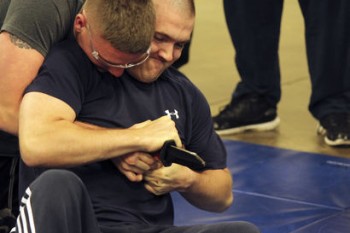
Cadets train with a “shock knife”—which emits an electrical charge to simulate getting cut—in order to learn how to subdue an inmate during a knife attack.
Editor’s Note: Public Safety reporter Henry Culvyhouse traveled to Glenville earlier this month to observe how correctional officers, who staff the state’s prisons, jails and local juvenile detention facilities, are trained. Arriving bright and early and staying until early afternoon, Culvyhouse was able to become the first journalist in West Virginia to fully participate in the facility’s first media day.
GLENVILLE, W.Va. — There’s not one guard keeping watch over the nearly 10,500 people in West Virginia’s jails, prisons and juvenile detention centers.
However, there are 2,410 correctional officers-CO’s in jail house parlance-monitoring the men and women and boys and girls housed in the state’s 18 correctional facilities, 10 regional jails and 10 juvenile detention centers. And COs, including the ones staffing the Eastern Regional Jail in Martinsburg, are made at the West Virginia Department of Military Affairs and Public Safety Professional Development Center in Glenville.
The 44,000-square-foot facility was established in 2010 in a partnership with Glenville State College to provide basic and specialized training for officers in the state’s Division of Corrections, Regional Jail Authority and Division of Juvenile Services.
Kim Conrad, the training center’s director, said COs do not simply receive their title when they become employed.
“They earn their title when they come to this center and undergo the six weeks of basic training,” she said.
The number one weapon: a word
Randy Perdue, training director for DOC, said when he transitioned into corrections from working in Military Police, he quickly discovered that policing and corrections were “two different animals.”
“The number one thing to realize is that every day you walk into that prison, you’re walking into danger,” he said. “Law enforcement must expect the unexpected in their day-to-day, but prisons are small cities, with stores, medical care, all of that, full of criminals.”
Most folks on the outside would think the best way to deal with prisoners would be to stay armed, utilizing a baton, Mace or a Taser (COs do not carry firearms inside a facility), but that’s not necessarily true, according to RJA training director Bill Canteburry.
“Inmates are already mad because they’re locked up, so the best way to prevent someone from getting hurt when an inmate gets confrontational is to deescalate the situation with your words,” he said. “Brains is more valued over brawn.”
To that end, cadets are taught interpersonal communication (IPC) skills in order to handle a situation, whether it be a conflict between inmates or between a CO and an inmate. Utilizing a mock block consisting of three cells-complete with drab grey walls and fluorescent lighting- where cadets (many of whom have worked in jails prior to their training) simulate these situations by role playing inmate-CO interactions, focusing on tone, body posture, gestures and the overall appearance of an inmate.
“IPC helps you maintain a level of composure whenever you’re dealing with an inmate giving you attitude, because most of these guys come from a not so good background, so it takes them back when you show them politeness and kindness,” one cadet said.
The training is especially important for officers in Juvenile Services, because handling residents (juveniles are not called inmates) requires a less hands on approach than in the adult population. But regardless of the populations age, “it takes a special breed” to deal with incarcerated folks, another cadet said.
“Inmates are in there 24/7 thinking of ways to manipulate COs, ways to find that one string to pull,” he said. “So to talk down the biggest, baddest guy on the cell block by not raising your voice or losing your temper requires a mentality that not everyone has.”
DOC, according to a January report on legislative report on vacancies in the division, experienced a 37 percent turnover rate in fiscal year 2014. According to Department of Military Affairs and Public Safety spokesman Lawrence Messina, the other two divisions are experiencing a similar turnover.
Three minutes to the line
For years, correctional officers in West Virginia were whipped into shape with pushups, chinups and situps. Just this year, according to Canteburry, a physical agility test was developed to prepare officers for the physical rigors of an emergency that may arise in a facility, whether it be a fight, a fire or a suicide attempt.
“In the RJA, we want to have a nine-second response time for when a CO calls for help for another officer to be there,” he said. “When you have staff running from one side of the jail to the other and then you have to pull people from danger, the old way of doing things just wasn’t cutting it.”
The course requires cadets to start at a line lying on their stomachs, then at the whistle, they run to the end of the gym, grab a five-pound weight and set it down at the starting line. Then they jump over three short hurdles before weaving in and out of cones. At the end of the cones is a 100-pound punching bag, which they must drag, before running to grab another weight.
After that, the course resets itself, because the cadet must go through the course again, Cpl. Ronnie Burkhammer said. In order to pass the test, a cadet has to complete the course in under three minutes.
“We started doing this on our first day,” one cadet said. “Some of us halfway through the course had our legs turn to jelly and fell right over. … A lot of us smoke, so this course really got us to cut down on our amount of cigarettes.”
‘You’re going to get cut’
“In this line of work, whenever an inmate has an edged weapon, you need to get it away from them, and whenever you’re doing that, you’re going to get cut,” the lieutenant told the cadets.
Prison made knives-shanks, as they’re called by correctional officers and inmates alike-are fashioned from virtually anything. Plastic utensils, paper, wire hangers, toothbrushes, anything that can be sharpened or fashioned into a blade is fair game-especially when inmates have plenty of time on their hands to perfect his or her craftwork.
For years, cadets were trained to handle knife attacks with rubber knives, however that proved ineffective because in the middle of the scuffle, they’d grab the blade, according to Conrad. So to prevent that and give the cadets a taste of what being cut is like, the training facility now uses “shock knives”-plastic knives that emit an electric charge along the blade to simulate the feeling of getting sliced.
The simulation is effective, albeit it lacks the coolness of a blade when it sinks into one’s skin.
The shock knife training is just one of the many courses cadets undergo in “defensive tactics.” The way cadets train is the cadet who holds the knife is the inmate, while the other cadet is the CO. For 30 seconds, the inmate attacks the CO, while the CO attempts to grab their wrist in a C-clamp hold-meaning they lock both hands around the wrist to limit its mobility.
Sgt. Daniel James said the bouts “can feel like an eternity.”
“Your perception of time is lost when you’re trying to get the knife away,” James said. “For those guys, that 30 seconds can feel like an eternity. But in the real situation, you’re trying to control that wrist hoping backup arrives.”
While getting cut is all part of the process, James said the typical cut received from a shank is “about two inches” so therefore the chance of excessive, even fatal, bleeding is low. Plus, the adrenaline dulls the pain, James said.
“You don’t normally feel the cuts until afterwards, after the attack,” he said. “Both you and the inmate have adrenaline running through your veins, so whenever you’re trying to get them under control, you have to remember your training. Even in that situation, you still want to use your verbal skills to remind them to drop the knife.”
And what if a 300-pound inmate who bench presses everyday attacks a 150-pound CO? James said “size doesn’t matter.”
“It’s really about the training,” he said. “Our guys and ladies are fit, but they aren’t muscled up like some of the inmates they deal with. The training is meant to account for those potential size discrepancies.”
The last resort
COs rarely carry a pistol, much less a shotgun or a rifle in the course of their day-to-day duties. Unless they’re on transportation duty (there is also specialized driving courses for driving prison vans) or on an observation tower at the edge of a facility’s walls, a gun is hardly ever issued.
Ron Casto, deputy director of training for DOC, was a U.S Marine before he became a correctional officer. At Glenville, he teaches COs how to use firearms to a “minimum proficiency.”
“Putting holes in a paper target is just a way to get your accuracy up,” Casto said. “There’s a lot more that goes into it; there’s speed, there’s pivots and turns, there’s shooting from behind cover, there’s shooting while moving. There’s a lot more that goes into it than just firing into a target.”
In matter of fact, firearms training does not start at the nearby gun range (a joint project between the college and the West Virginia Department of Natural Resources) but in the classroom, Casto said.
“Before you can think about employing any force, whether it be lethal or non-lethal, you have to justify what you’re doing,” Casto said. “You have to recognize the threat potential, recognize the indicators that a deadly assault is about to occur and see what kind of opportunity you have to employ the force.”
One of the exercises consists of a hulahoop cadets stand inside, then pivot themselves to fire down range. Another involves shooting metal targets with a shotgun, and after firing upon them, a “surprise”-clay skeet-is launched in the area to shoot.
Regardless of the multitudes of firearms exercises cadets undergo, Casto said the important thing is for everyone to come home.
“I have had to make a few of those calls over the years, to someone’s wife, to someone’s mother, to tell them they aren’t coming home,” he said. “If it comes down to using deadly force, then I want to teach cadets how to properly use it so they can go back home to their families and be able to tell them what happened at work.”
-Staff writer Henry Culvyhouse can be contacted at 304-263-8931, ext. 215, or twitter.com/HCulvyhouseJN.





